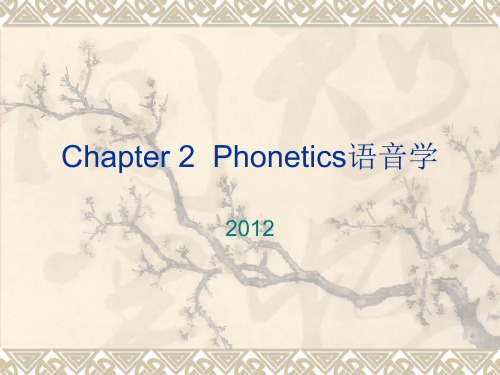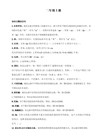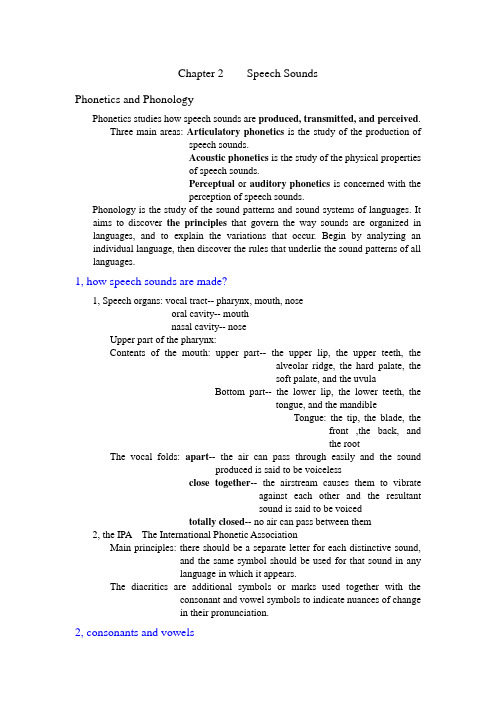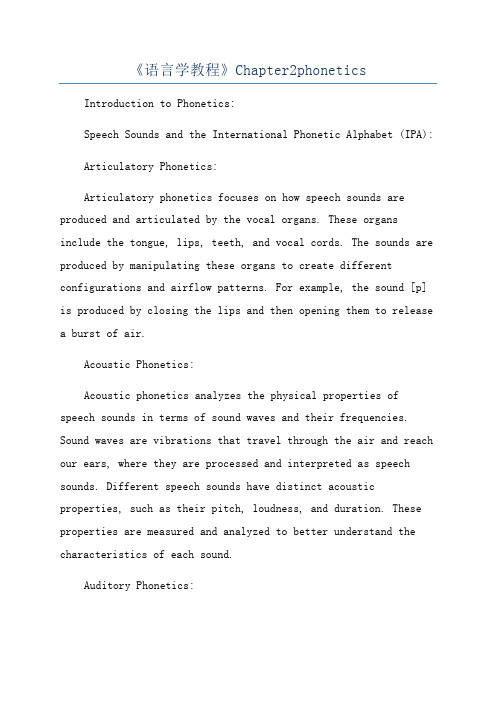《语言学教程》Chapter 2 phonetics
chapter 2 phonetics 语音学(2012)

The Cambridge Encyclopedia of Language, 2nd edition, 2002: 15
Articulatory Phonetics (发声语音学)
(Linguists’ interest)
studies from the speaker’s point of view, how speaker uses his organs to articulate sounds. Articulatory Phonetic description generally makes reference to six main factors: Air stream – vocal folds – soft palate – place of articulation – manner of articulation – lips Or two major factors: speech organs + articulation (place + manner)
How many segments /sounds in a word?
cough, bough, dough ? Meat, great, threat, Sea, bead, dead ?
(Ss
do the transcriptions by looking up in dictionary.)
Pitch
Theories of speech perception
Listeners
are active Listeners are passive Compromise
Study of the stages in humanmachine speech interaction
语言学chapter 2 phonetics

To make a speech sound visible so that we can measure its components objectively we must then go into the domain of acoustic phonetics, which studies the physical properties of speech sounds, as transmitted between mouth and ear.
3.1.2 Places of articulation
In terms of place of articulation, the English consonants can be classified into the following types:
bilabial
labiodental
j
4. Vowels (refer to Poole, 2000: 60)
4.1 cardinal vowels 基本元音(refer to Poole, 2000: 50-51)
British phonetician Daniel Jones first fixed the qualities of the two vowels which were produced with the tongue is as high and as far forward as possible in [i]. Another, represented by [a], is the sound produced when the tongue is as low as possible at the back. The other six vowels have been plotted down between these two extremes, the front vowels being plotted at equal acoustic distances as are the back vowels.
Chapter2Phonetics语音学

Chapter2Phonetics语音学Chapter Two Phonetics: Speech SoundsI. Fill in the blanks.1.____________ phonetics studies the movement of the vocal organs of producing the speech sounds.2.Speech takes place when the organs of speech move to produce patterns of sound. These movementshave an effect on the ____________ coming from the lungs.3.Consonants can be either ____________ or ____________, while all vowels are __________.4.Consonants can also be made when two speech organs in the mouth are brought close together so thatthe air is pushed out between them, causing ____________.5.The qualities of vowels depend upon the position of the ____________ and the lips.6.One element in the description of vowels is the part of the tongue which is at the highest point in themouth. A second element is the ___________ to which that part of the tongue is raised.7.In English there are a number of ____________, which are produced by moving from one vowelposition to another through intervening positions.II. Choose the best answer.1.The opening between the vocal cords is sometimes referred to ________.A. glottisB. vocal cavityC. pharynxD. uvula2.Which branch of phonetics concerns the production of speech sounds?A. Acoustic phoneticsB. Articulatory phoneticsC. Auditory phoneticsD. Neither of them3.Which one is different from the others according to the manners of articulation?A. [z]B. [w]C. [3]D. [v]4.Which one is different from the others according to the places of articulation?A. [n]B. [m]C. [b]D. [p]5.Which vowel is different from the others according to the characteristics of vowels?A. [i:]B. [u]C. [e]D. [i]6.What kind of sounds can we make when the vocal cords are vibrating?A. V oicelessB. VoicedC. GlottalD. Consonant7.Which consonant represents the following description: voiceless labiodental fricative?A. [f]B. [v]C. [z]D. [p]III. Decide whether the following statements are true [T] or false [F].1.Of the three phonetic branches, the longest established one, and until recently the most highlydeveloped, is acoustic phonetics.2.[p] is voiced bilabial stop.3.When pure or monophthongs are pronounced, no vowel glides take place.IV. Answer the following questions.1.In which ways may consonants be classified?2.What do speech organs (vocal organs ) include?3.What are broad transcription and narrow transcription?4.What does phonetics concern?。
新编简明语言学教程教案第2章

Chapter 2 PhoneticsContents:2.1.The phonic medium of language2.2.1 What is phonetics2.2.2 Organs of speech oral cavitynasal cavitybroad transcription 2.2.3 Orthographic representation of speech soundsnarrow transcriptionvowel2.2.4 Classification of English speech soundsconsonants2.3 phonology2.3.1 phonology and phonetics2.3.2 phone, phoneme, and allophone因素,音位和音位变体2.3.3 phonemic contrast, complementary distribution, and minimal pairSequential rulesAssimilation ruleDeletion rulestress2.3.5 Suprasegmental features toneintonation2.1.The phonic medium of language2.2.1. What is phoneticsPhonetics is defined as the study of the phonic medium of language, it is concerned with all the sounds that occur in the world’s language.语音学是指对语言的语音媒介进行的研究,它关注语言世界中的所有语音。
Articulatory phonetics----it studies how a speaker uses his speech organto articulate the sounds.Acoustic phonetics---- it studies the way sounds travel by looking at thesound waves, the physical means by which soundsare transmitted through the air from one person toanother.发音语音学通过观察声波研究语音的传播方式,即语音经过空气从一个人到达另一个人的物理方式。
《英语语言学导论》(第四版)课件Chapter 2 Phonetics

[v] and write a short paper on the problem in the acquisition of [v] and how to solve it.
Phonetic features and natural classes
Teaching Aims
The Study of Speech Sounds
1. To make students familiar with sound production mechanism, the transcription and description of English sounds. 2. To make students understand the differences of consonants and vowels, the nature of phonetic features and natural classes. 3. To cultivate students’ cross-cultural awareness and research interests in discovering the regularities of speech sounds.
2.3 Phonetic transcription of sounds
Transcription of sounds
2.3.1 Unit of representation Speech is a continuous flow of sound with interruptions only
胡壮麟《语言学教程》第三版语音学Phonetics课件.ppt

2021/4/15
Linguistics: A Coursebook
8
4.3 Coarticulation
Coarticulation: the influence on a sound by its
neighbors e.g. cap [kap]
f v θ ð s z ∫3
h
Approxi w mant
r
j
Lateral
l
Affricate
t∫ d3
Table 1 A chart of English consonants
2021/4/15
Linguistics: A Coursebook
11
5.3 Classification of vowels
2021/4/15
Linguistics: A Coursebook
9
5. Phonetic Classification
Vowels and consonants Classification of consonants Classification of vowels
2021/4/15
Linguistics: A Coursebook
2021/4/15
Linguistics: A Coursebook
6
4.1 Segment and divergence
Segment: any linguistic unit in a sequence which may be isolated from the rest of the sequence, e.g. a sound in an utterance or a letter in a written text. (Feasibility)
语言学教程 chapter2

Chapter 2 Speech SoundsPhonetics and PhonologyPhonetics studies how speech sounds are produced, transmitted, and perceived.Three main areas: Articulatory phonetics is the study of the production ofspeech sounds.Acoustic phonetics is the study of the physical propertiesof speech sounds.Perceptual or auditory phonetics is concerned with theperception of speech sounds.Phonology is the study of the sound patterns and sound systems of languages. It aims to discover the principles that govern the way sounds are organized in languages, and to explain the variations that occur. Begin by analyzing an individual language, then discover the rules that underlie the sound patterns of all languages.1, how speech sounds are made?1, Speech organs: vocal tract-- pharynx, mouth, noseoral cavity-- mouthnasal cavity-- noseUpper part of the pharynx:Contents of the mouth: upper part-- the upper lip, the upper teeth, thealveolar ridge, the hard palate, thesoft palate, and the uvulaBottom part-- the lower lip, the lower teeth, thetongue, and the mandibleTongue: the tip, the blade, thefront ,the back, andthe rootThe vocal folds: apart-- the air can pass through easily and the soundproduced is said to be voicelessclose together-- the airstream causes them to vibrateagainst each other and the resultantsound is said to be voicedtotally closed-- no air can pass between them 2, the IPA The International Phonetic AssociationMain principles: there should be a separate letter for each distinctive sound,and the same symbol should be used for that sound in anylanguage in which it appears.The diacritics are additional symbols or marks used together with theconsonant and vowel symbols to indicate nuances of changein their pronunciation.2, consonants and vowelsConsonants are produced by a closure in the vocal tract, or by a narrowing which is so marked that air cannot escape without producing audible friction.V owels is produced without such stricture so that air escapes in a relatively unimpeded way though the mouth or nose.The distinction between vowels and consonants lies in the obstruction of airstream.1, ConsonantsManner of Articulation: the way in which the air passes through certainparts of the vocal tract. It refers ways in which articulation can beaccomplished1, stop(or plosive)-- [p, b, t, d, k, g]2, nasal-- [m, n, etc.]3, fricative-- [f, v, s, z etc.]4, approximant-- [w, j etc.]5, lateral-- [l]6, trill-- [r]7, tap and flap8, affricateThe Place of Articulation: where in the vocal tract there is approximation,narrowing, or the obstruction of air1, bilabial-- made with two lips2, labiodental-- made with the lower lip and the upper front teeth3, dental-- made by the tongue tip or blade and the upper front teeth4, alveolar-- made with the tongue tip or blade and the alveolar ridge5, postalveolar-- made with the tongue tip and the back of thealveolar ridge6, petroflex-- made with the front of the tongue tip or blade curledback so that the underside of the tongue tip or bladeforms a stricture with the back of the alveolar ridgeor the hard palate7, palatal-- made with the front of the tongue and the hard palate8, velar-- made with the back of the tongue and the soft palate9, uvular-- made with the back of the tongue and the uvula10, pharyngeal-- made with the root of the tongue and the walls ofthe pharynx11, glottal-- made with the two pieces of vocal folds pushed towardseach other2, V owels[ i: ]-- high front tensed unrounded vowel[ə: ]-- mid central tensed unrounded vowel[a: ]-- low back tensed rounded vowel[ɔ: ]-- mid back tensed rounded vowel[u: ]-- high back tensed rounded vowel[i ]-- high front lax unrounded vowel[e ]-- mid front lax unrounded vowel[æ ]-- low front lax unrounded vowel[ə]-- mid central lax unrounded vowel[ʌ]-- low back lax rounded vowel[ɔ]-- mid back lax rounded vowel[u ]-- high back lax rounded vowel3, the sounds of EnglishRP-- R eceived P ronunciationGA-- G eneral A merican3, from phonetics to phonology1, coarticulation and phonetic transcriptionsCoarticulation: The simultaneous or overlapping articulation of twosuccessive phonological units.Anticipatory coarticulation-- the sound becomes more like the followingsound (lamb)Perseverative coarticulation-- the sound shows the influence of theproceeding sound (map)Broad transcription-- the use of a simple set of symbols in ourtranscriptionNarrow transcription-- the use of more specific symbols to show morephonetic detail2, phonemesThe smallest unit that distinguishes meaning of words. a unit of explicitsound contrastMinimal pair-- a pair of words with different meanings which differ in onlyone sound.E.g. “pill” and “bill”Phonetics transcriptions are placed between slant lines(/ /), whilephonetic transcriptions are placed between squarebrackets([ ]).3, allophonesThe aspirated /p/ and the unaspirated /p/ have phonetic differece, but theyboth belong to the same phoneme /p/. Such variants are called allophones ofthe same phoneme. In this case the allophones are said to be incomplementary distribution because they never occur in the same context.This phenomenon of variation in the pronunciation is called allophony orallophonic variation.To be allophones of the same phoneme, the phones must be phoneticallysimilar. Phonetic similarity means that the allophones of a phoneme mustbear some resemblance.If two sounds occurring in the same environment do not contrast; namely, ifthe substitution of one for the other does not generate a new word form butmerely a different pronunciation of the same word, the two sounds then aresaid to be in “free variation”.4, phonological process, phonological rules and distinctive features 1, AssimilationInstances: nasalization, dentalization, velarizationTwo possibilities-- 1, if a following sound is influencing a precedingsound, we call it regressive assimilation2, the converse process, in which a preceding soundis influencing a following sound, is known asprogressive assimilationPhonological process-- three aspects: 1, a set of sounds to undergo theprocess2, a set of sounds produced bythe processs3, a set of situations in which theprocess appliesPhonological rules2, epenthesis, rule ordering and the elsewhere conditionA boyAn appleWe treat the change of a to an as an insertion of a nasal sound.Technically, this process of insertion is known as epenthesis.3, distinctive featuresFirstly developed by Roman Jacobson as a means of working out a set ofphonological contrasts or oppositions to capture particular aspects oflanguage sounds.Some major distinctions-- consonantal, sonorant, nasal, voiced.5, suprasegmentals1, the syllable structureMonosyllabic-- with one syllablePolysyllabic-- with more than one syllableA syllable must have a nucleus or peak.Open syllable-- a syllable which ends in a vowel.Closed syllable-- a syllable which ends in a consonant.Maximal onset principle-- the principle which states that when there is achoice as to where to place a consonant, it isput into the onset rather than the coda.2, stressStress Stress refers to the degree of force used in producing a syllable.3, intonationIntonation involves the occurrence of recurring fall- rise patterns, each ofwhich is used with a set of relatively consistent meanings, either onsingle words or on groups of words of varying length.4, toneIn Chinese tone changes are made in a different way, affecting themeanings of individual words.Languages like Chinese are known as tone languages.。
《语言学教程》Chapter2phonetics

《语言学教程》Chapter2phoneticsIntroduction to Phonetics:Speech Sounds and the International Phonetic Alphabet (IPA): Articulatory Phonetics:Articulatory phonetics focuses on how speech sounds are produced and articulated by the vocal organs. These organs include the tongue, lips, teeth, and vocal cords. The sounds are produced by manipulating these organs to create different configurations and airflow patterns. For example, the sound [p] is produced by closing the lips and then opening them to release a burst of air.Acoustic Phonetics:Acoustic phonetics analyzes the physical properties of speech sounds in terms of sound waves and their frequencies. Sound waves are vibrations that travel through the air and reach our ears, where they are processed and interpreted as speech sounds. Different speech sounds have distinct acoustic properties, such as their pitch, loudness, and duration. These properties are measured and analyzed to better understand the characteristics of each sound.Auditory Phonetics:Auditory phonetics investigates how speech sounds are perceived and processed by the human auditory system. When we hear speech sounds, our ears detect the sound waves and send them to the brain for interpretation. The brain then matches these signals to specific speech sounds and recognizes their meaning. Auditory phonetics explores the mechanisms and processes involved in this perception and interpretation.Segmental and Suprasegmental Features:In linguistics, speech sounds can be classified into two categories: segmental and suprasegmental features. Segmental features pertain to individual sounds or phonemes, while suprasegmental features refer to properties that extend beyond individual sounds, such as stress, intonation, and rhythm. These suprasegmental features contribute to the melody and rhythm of speech and can carry additional meaning and emphasis.Phonetic Transcription:Conclusion:。
- 1、下载文档前请自行甄别文档内容的完整性,平台不提供额外的编辑、内容补充、找答案等附加服务。
- 2、"仅部分预览"的文档,不可在线预览部分如存在完整性等问题,可反馈申请退款(可完整预览的文档不适用该条件!)。
- 3、如文档侵犯您的权益,请联系客服反馈,我们会尽快为您处理(人工客服工作时间:9:00-18:30)。
2.2 Consonants and vowels
Preview questions: 1. What are consonants and vowels? 2. What is the major difference between consonants and vowels? 3. In what ways can we describe consonants and vowe.4 Competence and performance
Proposed by the American linguist N. Chomsky (psychological)
Competence: the ideal user’s knowledge of the rules of his language (语言 能力) Performance: the actual use of language in concrete situations (语言运用)
3. In terms of the state of the vocal cords: A. voiced: consonants produced when the vocal cords are closed, and the airstream causes them to vibrate again each other. B. voiceless: consonants produced when vocal cords are apart, and air passes through easily.
Chapter Two Speech Sounds
What is Phonetics?
Phonetics (语音学) studies how speech sounds are produced, transmitted, and perceived. It is concerned with all the sounds that occur in the world’s languages.
Classification of speech sounds
1. Consonants: are produced ‘by a closure in the vocal tract, or by a narrowing which is so marked that air cannot escape without producing audible friction’. 声道紧闭或声道变窄的程度达到气流无法 排出,一旦排出就会产生可闻的摩擦。 2. Vowels: By contrast, a vowel is produced without such ‘stricture’ so that ‘air escapes in a relatively unimpeded way through the mouth or nose’.
Review Questions
1. What are the main functions of language? 2. What is the main difference between prescriptive study and descriptive study? 3. What is the difference between langue and parole? 4. What is the main difference between competence and performance? 5. What is the main difference between langue and parole?
1. Speech organs 2. Descriptions of English consonants and vowels
2.1
How speech sounds are made?
Preview questions
1. What are the three cavities of the vocal tract? 2. What is the definition of IPA?
an instant or a relatively long period; – (b) they may narrow the space considerably; – (c) they may simply modify the shape of the tract by approaching each other.
1. In terms of manner of articulation: Ways in which articulation of consonants can be accomplished:
– (a) the articulators may close off the oral tract for
Phonetics Vs Phonology
1. Phonetics: speech sounds It is interested in all the speech sounds used in all human languages: phonetic features they possess, how they can be classified, etc. 2. Phonology: sound systems It aims to discover how speech sounds in a language form patterns and how these sounds are used to convey meaning in linguistic communication.
Chomsky
Differences between competence and performance
Competence
It enables a speaker to produce and understand an indefinite number of sentences and to recognize grammatical mistakes and ambiguities; It is stable.
Langue-parole Langue is a social product and a set of conventions for a community Saussure looks at language from a sociological or sociolinguistic point of view Competence-performance Competence is deemed as a property of the mind of each individual N. Chomsky deals with his issues psychologically or psycholinguistically.
Main contents in Chapter 2
Phonetics Speech sounds Sounds Phonology Sound systems 1. Phoneme, phone, allophone ClickPhonological 2. to add Title processes
2. In terms of place of articulation: The point where an obstruction to the flow of air is made in producing a consonant:
Description of consonants
14 咽 腔
2.1.2 The IPA
International Phonetic Alphabet: a set of phonetic symbols in the form of a chart (the IPA chart), designed by the International Phonetic Association since 1888. It has been revised from time to time to include new discoveries and changes in phonetic theory and practice. The latest version has been revised in 1993 and updated in 2005.
Performance
Performance is often influenced by psychological and social factors; it is not stable.
A speaker’s performance does not always match or equal his supposed competence. Chomsky believes that linguists ought to study competence, rather than performance. In other words, they should discover what an ideal speaker knows of his native language.
The distinction between vowels and consonants lies in the obstruction of the airstream. All the English vowels are typically voiced (voicing).
2.2.1 Descriptions of consonants
2.1.1 Organs of speech
